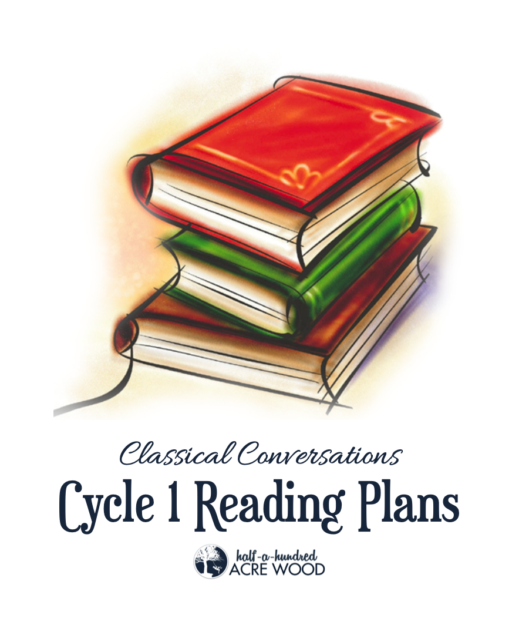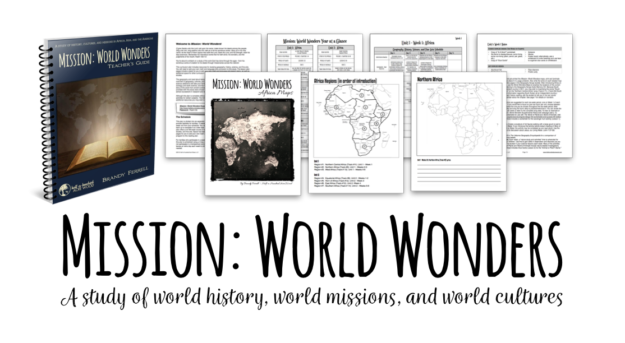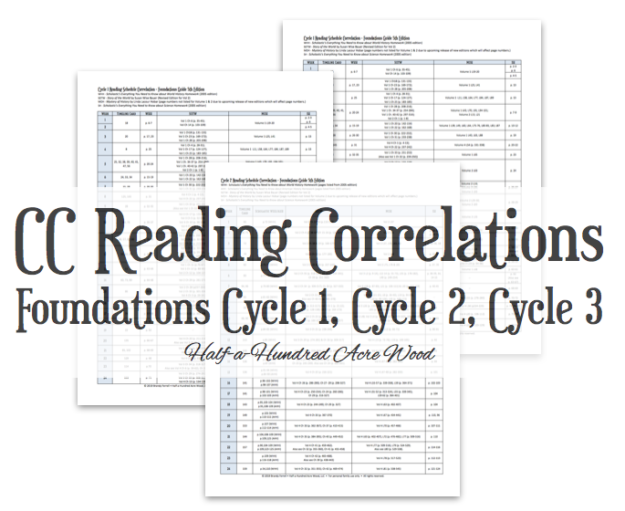
For those in the Classical Conversations Foundations program, you can always just start with the basics.
- A Bible
- The Foundations Guide
- A math program
- A language arts program (until your children are old enough for Essentials). We use a reading & spelling program that teaches phonics and then we teach sentence structure, punctuation, parts of speech, and so on via copywork and dictation. In addition to the Foundations English Grammar memory work, we’ve found IEW Bible Heroes (which comes with a free download of the Teacher’s Manual) to be immensely helpful prior to Essentials. We’ve also found that IEW’s Fix-It Grammar is a great curriculum with short lessons in which students apply concepts in sentence mechanics, parts of speech, and parts of a sentence.
- A library card. Your book selections need not even match up with your history or science memory work. Just read anything that your children enjoy!
- Paper and pencil.
But… if you’re looking for something to make the memory work come to life, we’ve got you covered right here!
What you’ll find here:
- CC Cycle 1 with Great Commission in Mind: Mission: World Wonders Reading Plan
- CC Cycle 1 Story of the World, Mystery of History, and Scholastic Reading Correlations
- CC Cycle 1 Read Alouds and Picture Books We Read
1. Cycle 1 with the Great Commission in Mind
After designing curriculum plans for nearly a decade, we’ve developed a Christian Classical Curriculum that integrates the study of the world and the ongoing fulfillment of the Great Commission, with a focus on loving God, His Word, and fellow mankind. For an open-and-go reading/curriculum plan that overlaps much of the memory work studied during Cycle 1 – with an integrated study of world missions, world empires & geography, fine arts, and science check out our Mission: World Wonders Curriculum Plan. This curriculum plan has changed the lives of many, including our family!
 Note: Although Mission: World Wonders is not directly correlated to the memory work, it includes a more complete study of biology, earth science, and history. The books selected for this reading plan were chosen as long-term resources for students to use when they embark on research and world geography memorization in grades 7+. For families who use Classical Conversations®, the readings assigned in the Mission: World Wonders study overlap much of the memory work studied during Cycle 1 but is not correlated week by week. This provides an opportunity for ongoing review and integration of the memory work throughout the year.
Note: Although Mission: World Wonders is not directly correlated to the memory work, it includes a more complete study of biology, earth science, and history. The books selected for this reading plan were chosen as long-term resources for students to use when they embark on research and world geography memorization in grades 7+. For families who use Classical Conversations®, the readings assigned in the Mission: World Wonders study overlap much of the memory work studied during Cycle 1 but is not correlated week by week. This provides an opportunity for ongoing review and integration of the memory work throughout the year.
2. Cycle 1 SoTW, MoH, and Scholastic Correlations
If you are primarily interested in Story of the World, Mystery of History, and Scholastic Reading Correlations, check out our SOTW reading correlations to download an updated reading correlation for 5th edition.
 The Cycle 1 Reading Correlations are also available in our Updated Cycle 1 Planners.
The Cycle 1 Reading Correlations are also available in our Updated Cycle 1 Planners.
3. Read-Aloud & Picture Books
These read-alouds were selected for our children over six years ago when they were all in elementary school. (Our oldest has graduated high school and is now in college.) Below is a little about each of the read alouds I selected that year, but if you’d like to read about our favorite read alouds and picture books related to Cycle 1, visit Our Favorite Cycle 1 Read Alouds and Our Favorite Cycle 1 Picture Books.
Please know that I do not include anything on this list that we have not invested in ourselves. I have included affiliate links because it is a way to support the high cost of running this website. If you use our affiliate links, thank you so much – it is your support that has allowed us to continue providing resources here at Half-a-Hundred Acre Wood.
A Cry from Egypt. A well-written blend of Jewish and Egyptian history (historical fiction) written from a Christian perspective. {Update: We loved this book!}
Archimedes and the Door of Science. Bendick. An intriguing way to connect science to our history studies. {Update: We loved this book!}
Illustrated Stories from the Greek Myths OR The Usborne Book of Greek Myths OR Illustrated Stories from Aesop. Realizing that some prefer not to study the Greek Myths, I have provided the option of studying Aesop’s fables. I have read through large portions of each of these three books, and all of them are delightfully entertaining. (Illustrated Stories from Greek Myths is geared more towards younger children, and the longer Usborne Book of Greek Myths is geared more towards older children. Both are very well written and are more engaging (in my opinion) than D’aulaire’s Book of Greek Myths.) We plan to read all three of these books in the coming year, although I’ve only “scheduled” the reading of one of them. {Update: We love the Usborne books on myths.}
Detectives in Togas. Winterfield. Engaging read for our family. Mystery + history + a small dose of silliness = fun. {Update: We loved this book!}
Who Was Gandhi? Rau. A broad overview of the life of Gandhi with historical insets about things like the caste system. {Update: This is a great introduction to Gandhi.}
Who Was Queen Victoria? Gigliotti. A broad overview of the reign of Queen Victoria with factual insets. Easy to understand and engaging for our children. {Update: This is a great introduction to Queen Victoria!}
Heart of a Samurai. Preus. The longest of all the books on our list this year, Heart of a Samurai gives us a glimpse into the period of isolation. {Update: We loved this book!}
David Livingstone: Africa’s Trailblazer (Christian Heroes: Then & Now). Benge. Although David Livingstone may not be the best role model for missions (due to his enthusiasm for adventure vs. parenthood), this book gives a glimpse of Africa, the slave trade, and other events on our timeline. {Update: We enjoyed this book.}
Awesome Ancient Ancestors!: Mound Builders, Maya, and More (America’s Horrible Histories). Levy. This book provides a comical and engaging way to discuss the early North Americans. A break from the heavier reading for this semester. {Update: We did not care for this book.}
Exploration and Conquest: The Americas After Columbus: 1500-1620 (American Story) This is a thin book that would be considered more of a picture book than a read aloud, but it relates to several memory work sentences and provides a break from the longer readings this year. {Update: This book provides a good overview but is not one of our favorites.}
Om-Kas-Toe. Thomasma. I wanted to select a story featuring Native Americans because our memory work does not provide much of a chance to go into this culture much. I selected this one because this author (and this book) comes highly recommended by trusted sources. {Update: We enjoyed this book, although it has not been a top pick for us.}
O Canada, Her Story. Akins. A collection of biographical stories about Canada from one of our favorite companies, Knowledge Quest. {Update: We enjoyed this book.}
Nate Saint: On a Wing and a Prayer. Benge. Another inspiring missionary biography (which ties into our timeline event Jim & Elisabeth Elliot). {Update: We loved this book! Rachel Saint is great to follow it up with because it continues the story from Nate’s sister’s perspective, and you can see the amazing power of forgiveness and love – and how it changed the lives of the ruthless Waoroni tribe.}
The Bronze Bow. Speare. A highly recommended book set in the Roman times, scheduled for weekend reading throughout the first semester. This one will be re-read in Challenge. {Update: We loved this book!}
Carry On, Mr. Bowditch. Although this book does not tie in to our Cycle 1 history, it is loosely connected to our memory work because of the nautical/science connections – and it is a wonderfully fascinating book that encourages a love of learning. We have enjoyed this book so much that we are re-reading it again next year. (And it will be re-read again in Challenge.) {Update: This book is a top-notch absolute favorite for our family. Some prefer to read it in conjunction with American history, but it’s good to read no matter which cycle you’re in!}
Picture Books (History)
King Solomon & the Queen of Sheba. Greenberg This book is incredibly fascinating! A blend of Jewish history and African history!
You Wouldn’t Want to Be a Pyramid Builder!: A Hazardous Job You’d Rather Not Have. Morley This somewhat silly series is a favorite of our boys.
Explore Within an Egyptian Mummy. Hopping We found this at a discount store at some point. Very neat to pull out the mummy model for some hands-on learning!
The Librarian Who Measured the Earth. Lasky. Fabulous book about the Greek geographer/mathematician/librarian Eratosthenes who measured the earth with amazing accuracy.
Alexander the Great. Demi. (Illustrated) Demi’s books are just beautiful!
One Grain Of Rice: A Mathematical Folktale. Demi This mathematical folktale comes from India.
Marco Polo. Demi. Another of Demi’s beautiful books highlighting the travels of Marco Polo (China and India)
Timeline Graphic Novels: The First Emperor Comic-style book about ancient China with historical insets.
Built to Last. Macauley. A combination volume of Macauley’s Cathedral, Castle, and Mosque. Also good to reference in Cycle 2. (We also own City, which is about Roman city planning and construction.)
Bringing the Rain to Kapiti Plain. Aardema. In the same tone as “The House that Jack Built,” this book’s rhythmic rhyme makes it a favorite of our boys.
Why Mosquitoes Buzz in People’s Ears: A West African Tale. Aardema. We love West African Folktales, and this one is also a family favorite!
The Sad Night: The Story of an Aztec Victory and a Spanish Loss. A beautiful book with great historical information regarding Hernan Cortes and the Aztecs.
O Canada. Harrison. (Illustrated) Beautiful book with the words of the Canadian national anthem.
A Picture Book of Simon Bolivar. Adler. One of the few picture books available about the liberation of South America.
Napoleon: The Story of the Little Corporal. Burleigh. Illustrated book with great quotes and information about Napoleon. A great book for both Cycle 1 and 2.
The Heroic Symphony. Celenza. A look at Beethoven’s Heroic Symphony and how it relates to Napoleon. A great book for both Cycle 1 and 2.
Leveled Readers
Tut’s Mummy Lost & Found (Step-Into-Reading). Donnelly.
The Trojan Horse: How the Greeks Won the War (Step into Reading). Little
Romulus and Remus (Ready-to-Reads)
Pompeii: Buried Alive! (Step into Reading). Kunhardt.
To the Top: Climbing the World’s Highest Mountains (Step Into Reading). Kramer.
Amistad: the Story of a Slave Ship (Penguin Young Readers, L4)
Science and Math (Readings and Picture Books)
The World of Plants (God’s Design for Life)
A Childs Geography Explore His Earth (Vol 1). Voskamp
Our Weather & Water (God’s Design for Heaven & Earth). Lawrence.
Where Butterflies Grow. Ryder
Zinnia’s Flower Garden. Wellington
The Magic School Bus Inside the Earth (Magic School Bus)
Maps and Globes (Reading Rainbow Book) Great for both Cycle 1 and 2.
Geography from A to Z: A Picture Glossary. Knowlton Great book that can also help with geography/geology terminology in Challenge.
Big Book of Earth & Sky. Hodge. Wonderful book written from creationist perspective.
DK Eye Wonder Weather
Sir Cumference and the Dragon of Pi (A Math Adventure) We love all of the Sir Cumference books! Great living math!
Sir Cumference and the First Round Table (A Math Adventure)
Other Picture Books (Fine Arts & English)
Ish by Peter Reynolds. Our favorite book related to Fine Arts.
Not a Box
The Turn-Around, Upside-Down Alphabet Book Fun book that requires you to turn the book sideways and upside down to imagine each letter as… something else.
Mirror Mirror: A Book of Reversible Verse Mirror images and mirrored poetry. This is a favorite read for when we’re tackling mirror images in the first six weeks.
Art Fraud Detective: Spot the Difference, Solve the Crime! Trick your children into studying art in detail!
Story of the Orchestra : Listen While You Learn About the Instruments, the Music and the Composers Who Wrote the Music!
Under, Over, by the Clover: What is a Preposition? by Brian P. Cleary We love all the Brian Cleary books! Easy way to introduce parts of speech to younger children!
Around the House the Fox Chased the Mouse: Adventures in Prepositions by Rick Walton
Vinny the Action Verb and Lucy the Linking Verb by Coert Voorhees
Mozart: The Wonder Child: A Puppet Play in Three Acts. Stanley. I just love this book about Mozart!!!
Notebooking Resources
Our Classical Notebook
Posts about Notebooking
Comic Illustration Notebooking Pages {Free Printable}
Timeline Notebooking
Timeline Thumbnails
How to Notebook through Science or History
Beginner’s Guide to Copywork, Dictation, and Narration
Multiplication Drill Sheet {Free Printable}
Draw What You Hear Page (Classical Music) Notebooking page referenced in the following post: Classical Music Study Using Free Squilt Lessons
Continental Blob Maps
Drawing World Map Free-Hand: Major Circles of Latitude
Other related posts
CC Cycle 1 Planners with Booklists & Reading Correlations
CC Reading Correlations (All Cycles)
CC Cycle 1 Booklist
CC Cycle 1 Supplemental Resources Page
For a list of our favorite Cycle 1 read alouds and picture books, click on the following: Cycle 1 Read Aloud Favorites | Cycle 1 Favorite Picture Books. If you are searching for a different Cycle, please visit our Cycle 2 Resources Page or our Cycle 3 Resources Page.
